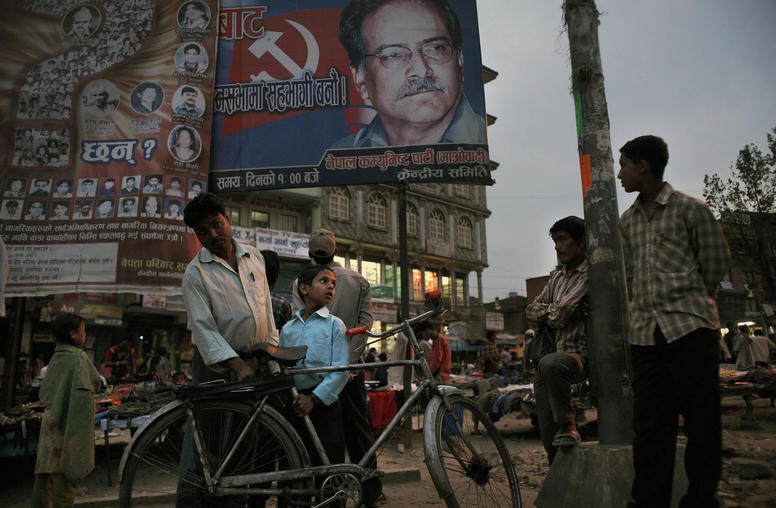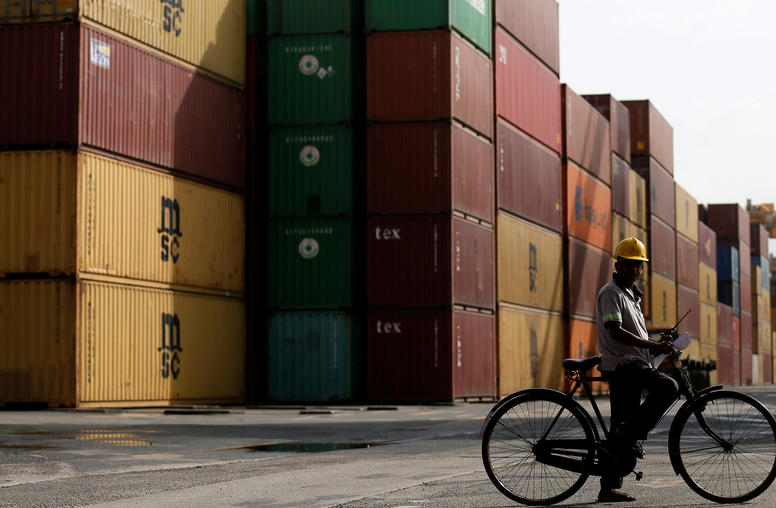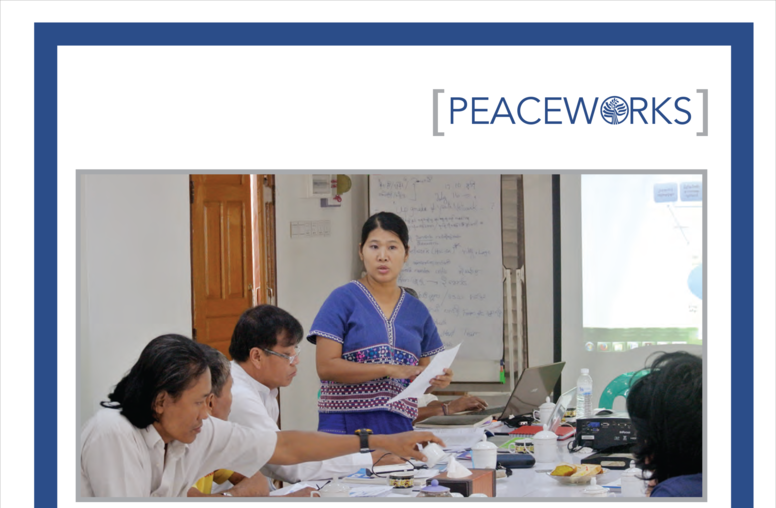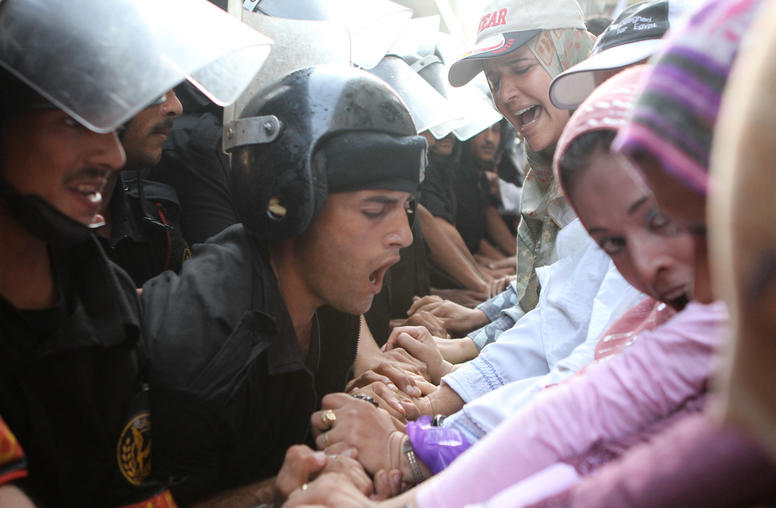Security Sector Reform in Nepal: The Role of Civil Society
What is the role of civil society in Nepal? In the wake of ongoing peace negotiations that resulted in the signing of a peace agreement, USIP sponsored a two day program in Nepal to discuss the concepts of Security Sector Reform, Disarmament, Demobilization, and Reintegration, and how they fit within the context of Nepal.
On August 31 and September 1, 2006, the United States Institute of Peace sponsored a two-day program in Kathmandu, Nepal. This two-day program brought together a broad spectrum of Nepali civil society, including representatives of human rights organizations, dalit and janjayti rights groups, development agencies, and student, media, and academic communities, to discuss the issue of security sector reform in Nepal and civil society's role in the wake of ongoing peace negotiations that subsequently resulted in a peace agreement signed by the government of Nepal and the Communist Party of Nepal-Maoists (CPN-M) in November 2006.
The program was organized by Karon Cochran-Budhathoki of Defend Human Rights Movement-Nepal and Colette Rausch, deputy director of USIP's Rule of Law program. It was facilitated by Ann Fitz-Gerald and Gordon Hughes of the Centre for Security Sector Management at Cranfield University, who presented participants with a broad range of case studies on security sector reform from other countries in transition.
This USIPeace Briefing provides an overview of the in-depth discussions that took place during the course of this program. It reviews the concepts of Security Sector Reform (SSR) and Disarmament, Demobilization, and Reintegration (DDR), and how they fit within the context of Nepal, as well as the ongoing challenges and needs for SSR, and the potential role for civil society. The areas of SSR that are highlighted in the report were identified as priority areas by members of civil society who participated in the USIP program. These priority areas include defense reform, the rule of law, democratic oversight, and DDR. The annex to the report contains the recommendations and action plan for civil society that directly resulted from USIP's program.
Context
On April 24, 2006, under pressure from daily public demonstrations that began April 6, Nepal's King Gyanendra reversed his February 1, 2005, declaration of direct palace rule and reinstated the House of Representatives (HoR). The seven political party alliance (SPA), which had opposed the King's absolute rule, came together to form a partial cabinet and select a prime minister. The government agreed to hold a constituent assembly election that would lead to a new constitution.
Following these events, the government and Communist Party of Nepal-Maoists (Maoists) continued to build on the dialogue that had begun between the Maoists and the SPA in November 2005, which had led to a 12-point understanding. The first "official" round of talks took place on May 26, 2006, and resulted in a 25-point ceasefire code of conduct. The second "official" round of talks finished on June 15, 2006, resulted in a four-point agreement to hold summit talks between the prime minister and Maoist Chairman Prachanda; to form a truce monitoring team (Ceasefire Code of Conduct National Monitoring Committee); to request the UN to assist the truce monitoring team and to monitor human rights; and finally, to hold further talks under observers.
Subsequently, summit talks were held on June 16 and resulted in an eight-point agreement to, among other things, dissolve the HoR, set up an interim government that would include the Maoists, enforce an interim constitution, and dissolve the Maoist de facto parallel government and judicial system that had been established in as much as 70% of the countryside. While some steps were taken for implementation, such as establishing a six-member interim constitution drafting committee, the peace process stalled over the sticking points of arms management and the future role of the king.
On November 21, 2006, Nepal's government and the Maoists signed a comprehensive peace agreement to formally end the ten-year conflict in Nepal that had resulted in an estimated 13,000 deaths. The peace agreement reaffirmed calls for UN involvement in arms management and elections monitoring, pledged to abide by international human rights and humanitarian laws, and called for the establishment of committees to undertake aspects of implementation. Under the agreement, and the November 28, 2006, Agreement of Monitoring the Management of Arms and Armies, the Maoists will sequester their armed fighters in cantonment sites, and the Nepalese Army will return to its barracks. The peace agreement has been widely hailed as historic within the country and many feel cautiously optimistic given the hurdles that lie ahead. Security sector issues remain in the forefront of challenges facing Nepal and implementation of the peace and arms management agreements.
Security Sector Reform and Disarmament, Demobilization, and Reintegration
 Courtesy University of Texas Libraries
Courtesy University of Texas LibrariesSecurity Sector Reform (SSR) is "another term used to describe the transformation of the 'security system'--which includes all the actors, their roles, responsibilities and actions--working together to manage and operate the system in a manner that is more consistent with democratic norms and sound principles of good governance, and thus contributes to a well-functioning security framework."1 The security system mentioned in this definition encompasses, among other agencies, core security actors like armed forces, police, paramilitary forces, intelligence and security services (both military and civilian), the judiciary, penal systems, human rights commissions, and customary and traditional justice systems.2 It includes security and management oversight bodies such as the executive, the legislature, ministries of defense and internal affairs, and civil society. Furthermore, the concept of "security sector" also encompasses non-statutory security forces such as liberation armies and private security companies.3 The protection of human security is a key goal of development with each affecting and informing the other at the strategic, operational, and programmatic levels. Likewise, SSR is part of a democratization agenda and post-conflict reconstruction strategy.
At a programmatic level, SSR includes initiatives such as defense reform, police reform, judicial reform, parliamentary oversight, democratic accountability and transparency, and strengthening civil society. Defense reform includes the reform of uniformed forces, the ministry of defense, and the home ministry, and consists of restructuring or strengthening these institutions and their interaction both strategically and operationally. Training is often prioritized in countries in transition; however defense reform is a much broader initiative that may include capacity-building programs to increase the ministries' ability for oversight or the redesign or development of oversight mechanisms. Beyond defense reform, police, judicial, and penal system reform may also be high on the SSR agenda. In a country transitioning out of conflict there is often a breakdown of law and order, and the police, as internal security actors, may not be fully operationally effective. Efforts may be made to provide training, equipment and other institutional or legal reforms to improve upon its operational effectiveness and ensure that it operates under democratic principles. The judiciary, the penal system, and the intelligence services may undergo similar reforms. Strengthening civil society is also a core component of SSR. A robust civil society acts as an effective oversight mechanism. In addition, civil society may stimulate dialogue on SSR reforms, often working with policymakers by providing much-needed data and research to inform their decisions.
SSR requires strategic planning and developing programs based on a holistic approach that looks at the various security actors as an integrated and comprehensive unit. SSR also requires a strong partnership between domestic actors (both policymakers and civil society) and development donors. But there is general agreement in the development community that SSR should be locally owned, led, and driven. As part of this reform process, widespread consultation is fundamental as the community as a whole seeks to define and respond to threats. Sufficient political will and strong leadership are vital to ensure effective long-term SSR strategies and their effective implementation. Also vital is the role of civil society as a key driver of change.
Disarmament, Demobilization, and Reintegration (DDR) is a core component of SSR and is usually conducted at the front-end of SSR reforms, close to the cessation of a conflict or the signing of a peace agreement. Disarmament involves the collection and disposal of weapons and/or their surveying, storage, registration, and/or destruction. Demobilization involves the disbandment of armed groups for administrative processing and discharge orientation. It may include, among other things, the establishment and management of temporary camps in which ex-combatants receive training for returning to civilian life or for integration into the national security forces. Finally, Reintegration programs seek to reintegrate former combatants into society through compensation, training programs, and employment opportunities. As part of reintegration programs, ex-combatants might receive social counseling and incentives for returning to their communities and re-establishing civilian life. DDR will be most successful if it supports a national agenda and development strategy. For example, if former combatants are being provided with new professional skills, it is crucial that there be a demand for these skills in the country. Reconstruction and development programs are often included as part of DDR, and depending upon the national needs and agenda, disarmament, demobilization, and reintegration may not be sequential. No matter the sequence or process for DDR, it is a program that should be designed and implemented as part of the broader SSR agenda.
Security Sector Reform Priorities in Nepal: Identifying Needs & Challenges
Nepal is a country attempting to transition into a sustainable democratic system and out of a ten-year violent conflict. The country must have a long-term development strategy to address issues such as its high unemployment rate, high illiteracy rate, lack of access to health facilities, and socio-economic trends that are steeped in caste, gender, and ethnic discrimination. While the peace process continues, splinter groups and criminal gangs are operating freely, causing increasing insecurity. This insecurity, the challenges to transition, and the need for a development agenda all indicate the necessity of having an SSR in Nepal. A strong and effective SSR strategy and programs, which would include DDR as well as development and democratization agendas, will greatly reduce the risk of failure of the comprehensive peace agreement. Under the USIP-run civil society program in Nepal, four areas were identified by civil society as SSR priorities: Defense Reform; Rule of Law; Good Governance and Democratic Oversight; and DDR. Challenges within each of these priority areas highlight the need for SSR in Nepal.
1. Defense Reform
For more than 200 years the Nepal Army (formerly the Royal Nepal Army) has been under the control of the monarchy of Nepal. Consequently, many at USIP's civil society program viewed the army as protecting the interests of the king rather than the security and interests of the Nepali people or a democratic government. Furthermore, they raised concerns about the army's human rights record, its involvement in internal security matters, and allegations of discriminatory practices within the ranks. In light of these concerns, many argued for reform of the army.
2. Rule of Law
Under the broad heading of the "Rule of Law" as a priority area for SSR in Nepal, civil society identified police reform, justice reform, and intelligence reform as key areas to address. The need to undertake police, justice, and intelligence reform has been increasingly emphasized due to the increase in domestic and cross-border crime since the restoration of the HoR and the start of the formal dialogue between the government and the Maoists. Organized criminal gangs, splinter groups of the Maoists, and vigilante and other armed groups are operating freely in Nepal. The Nepali police, and the entire criminal justice system, are struggling to adequately address serious crimes. In the absence of state action in criminal matters, many are taking the law into their own hands. Coupled with this, a parallel system of justice, run in Maoist-held territory, has continued to operate. The significant crime problems Nepal faces, in addition to the problem of illegitimate actors filling the "rule of law vacuum," needs to be urgently addressed. The police force as a whole needs to be strengthened, trained, and provided adequate resources in order to confront this phenomenon. Beyond the police force, the entire criminal justice system may need to be strengthened in order for Nepal to move toward a society based on the rule of law and justice. Issues of corruption and nepotism also need to be urgently addressed.
Another major rule of law challenge is the issue of accountability of Maoists and the security sector, including the army and the police, for violations of domestic law and international human rights and humanitarian law. In many cases, the Maoists and the army have operated with impunity and the Maoists have continued to violate signed understandings by continuing to extort, abduct, and recruit minors. Victims of the conflict must be granted access to justice to seek recourse for such violations of their fundamental rights. Currently, access to justice, both for violations during the conflict and more broadly for criminal offenses committed, has been limited due to lack of political will, a weak justice sector, and a lack of lawyers, judges, and courts outside of district headquarters.
3. Good Governance and Democratic Oversight
This priority addresses the interface between the security forces and the democratic government, as well as the politics of transformation. The concept of democratic oversight has never been implemented in Nepal. Furthermore, insufficient financial oversight of the security sector has been a long-standing issue. In Nepal, where the government is bound to democratize and oversee the operation of the army, a lack of coordination and information-sharing between civilian and military authorities has created many logistical and operational walls to the government effectively implementing its oversight function. Lack of political will, hesitancy in overseeing the security forces, and lack of division of labor within the government ministries has further hampered the police force's ability to effectively fight crime within the country.
4. DDR
DDR was a major sticking point for the peace process, and is still not viewed through the wider lens of SSR. Civil society members in Nepal strongly believe that a DDR program for the Maoists' Peoples Liberation Army (PLA) will not be sufficient unless there are concurrent programs for changing state security institutions. The international community has also created challenges through demands for complete disarmament. The timeframes discussed for a DDR program, whether by the government, civil society, or the international community, have been unrealistic. Because so many of the root causes of the conflict revolve around socio-economic discrimination and other development challenges, DDR should be part of a national recovery agenda. While the November 28, 2006, Agreement of Monitoring the Management of Arms and Armies addresses issues of cantonment and the possible integration of the PLA into the Nepal army, reintegration modalities have not been determined, concerns regarding the interests of women and child combatants were not addressed, and reform of the security sector was neglected. Furthermore, civil society has been largely excluded from the process, but is expected to assist in the implementation of the peace and arms management agreements. Reconstruction, rehabilitation, and restorative justice have not been considered while planning for DDR. The agreements continue to see DDR as alien to a larger development and democratization agenda, or as part of a larger SSR strategy.
Notes
1. Organization for Economic Co-Operation and Development, 'Security Sector Reform and Governance: A DAC Reference Guide', (2005), p 20, (available at http://www.oecd.org/dataoecd/8/39/31785288.pdf)
2. Organization for Economic Co-Operation and Development, 'Security Sector Reform and Governance: A DAC Reference Guide', (2005), pp 20-21 (available at http://www.oecd.org/dataoecd/8/39/31785288.pdf)
3. Organization for Economic Co-Operation and Development, 'Security Sector Reform and Governance: A DAC Reference Guide', (2005), pp 20-21 (available at http://www.oecd.org/dataoecd/8/39/31785288.pdf)
This USIPeace Briefing was written by Karon Cochran-Budhathoki, of Defend Human Rights Movement - Nepal. The views expressed here are not necessarily those of the Institute, which does not advocate specific policies.
The United States Institute of Peace is an independent, nonpartisan institution established and funded by Congress. Its goals are to help prevent and resolve violent international conflicts, promote post-conflict stability and development, and increase conflict management capacity, tools, and intellectual capital worldwide. The Institute does this by empowering others with knowledge, skills, and resources, as well as by directly engaging in peacebuilding efforts around the globe



